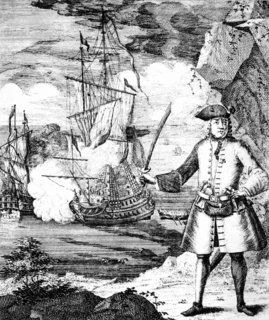 W
WThe privateer brig Admiral Juel was the second largest ship in Denmark-Norway to be granted letters of marque during the Gunboat War between Denmark and Britain. The British Royal Navy captured her in a notable single ship action in 1808.
 W
WDainty was an English race-built galleon that began to be built in 1588. The original name was Repentance, but this was soon changed. She participated in some naval engagements in the Anglo-Spanish War (1585–1604). In 1593 she sailed from England under Richard Hawkins to navigate the Pacific Ocean and circumnavigate the world, but was captured the following year by the Spaniards when she was sailing off the coast of what is now Ecuador. She was commissioned by the Spaniards as Nuestra Señora de la Visitación, serving in the South Pacific for several years.
 W
WFancy was Henry Every's ship, and was commanded by him between May 1694 to late 1695, when he retired from piracy and the fate of Fancy becomes unknown.
 W
WGalleons were large, multi-decked sailing ships first used as armed cargo carriers by European states from the 16th to 18th centuries during the age of sail and were the principal vessels drafted for use as warships until the Anglo-Dutch Wars of the mid-1600s. Galleons generally carried three or more masts with a lateen fore-and-aft rig on the rear masts, were carvel built with a prominent squared off raised stern, and used square-rigged sail plans on their fore-mast and main-masts.
 W
WGeneral Armstrong was an American brig built for privateering in the Atlantic Ocean theater of the War of 1812. She was named for Brigadier General John Armstrong, Sr., who fought in the American Revolutionary War.
 W
WGolden Hind was a galleon captained by Francis Drake in his circumnavigation of the world between 1577 and 1580. She was originally known as Pelican, but Drake renamed her mid-voyage in 1578, in honour of his patron, Sir Christopher Hatton, whose crest was a golden hind. Hatton was one of the principal sponsors of Drake's world voyage. A full-sized, seaworthy reconstruction is in London, on the south bank of the Thames.
 W
WThe Heroína was a privately owned frigate that was operated as a privateer under a license issued by the United Provinces of the River Plate. It was under the command of American-born Colonel David Jewett and has become linked with the Argentine claim to sovereignty of the Falkland Islands.
 W
WMohawk was a ship launched at Beverly, Massachusetts in 1781. She became a privateer, making two voyages. In 1782 the Royal Navy captured her and briefly took her into service under her existing name before selling her in 1783. She then became a merchantman until some investors in Bristol bought her in 1796 and turned her into a privateer again. In 1799 she became a letter of marque, but the French Navy captured her in 1801. She then served in the French Navy, capturing a British privateer in 1805, and was sold in 1814.
 W
WThe Prince de Neufchatel was a fast sailing United States schooner-rigged privateer, built in New York by Adam and Noah Brown in approximately 1812. She is a fine example of the peak of development of the armed schooner. Neufchatel operated in mainly European waters, damaging British shipping during the War of 1812. Noted for her speed, at one time she outran seventeen men-of-war. In 1813, operating in the English channel, she took nine British prizes in quick succession. She also delivered a crushing defeat to the boats of a British frigate that tried to capture her. The British finally captured her in December 1814; she was broken up in 1815.
 W
WRover was a privateer brig out of Liverpool, Nova Scotia known for several bold battles in the Napoleonic Wars.
 W
WSir Henry Ughtred or Oughtred was a merchant and shipbuilder during the reign of Elizabeth I. One of his ships, the Leicester sailed with Sir Francis Drake against the Spanish Armada. He was elected MP for the seat of Marlborough in 1584 and of Great Bedwyn in 1589. A wealthy landowner, Ughtred played an active role in the Plantations of Ireland and was knighted by the Lord Deputy in 1593. He was the son of Sir Anthony Ughtred and Elizabeth Seymour, sister to Jane, the third wife of Henry VIII. Sometime after 1557 he married Elizabeth, widow of Sir William Courtenay and daughter of John Paulet, 2nd Marquess of Winchester.
 W
WHMS Vincejo, was the Spanish naval brig Vencejo, which was built c.1797, probably at Port Mahon, and that the British captured in 1799. The Royal Navy took her into service and she served in the Mediterranean where she captured a privateer and a French naval brig during the French Revolutionary Wars. After the start of the Napoleonic Wars, the French captured Vencejo in Quiberon Bay in 1804. The French Navy took her into service as Victorine, but then sold her in January 1805. She then served as the French privateer Comte de Regnaud until the British recaptured her in 1810. The Royal Navy did not take her back into service.
 W
WThe White Lion was an English privateer operating under a Dutch letter of marque which brought the first Africans to the English colony of Virginia in 1619, a year before the arrival of the Mayflower in New England. Though the African captives were sold as indentured servants, the event is regarded as the start of slavery of Africans in colonial North America.